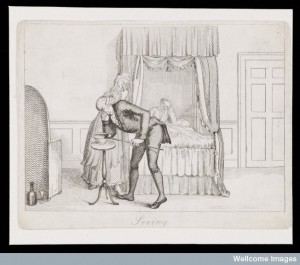By Helen King (Regular Contributor)
 Feces are in the news again, with a further story pointing to the potential benefits of fecal transplants in a range of bowel conditions. The internet includes DIY advice along with suggestions of banking our own poo so that we can reboot our digestive system from it if anything goes wrong.
Feces are in the news again, with a further story pointing to the potential benefits of fecal transplants in a range of bowel conditions. The internet includes DIY advice along with suggestions of banking our own poo so that we can reboot our digestive system from it if anything goes wrong.
Examining the patient’s bodily products, as in this 1826 image, has long been a part of medicine. But that’s examining, not inserting. As I’ve explained elsewhere, when it came to animal excrement, ancient Greek and Roman medicine was pretty relaxed about its possible curative powers, although Galen notoriously offered a remedy for white odor-free dog dung suitable for those of a nervous disposition. In the history of medicine, poo has been just one of the wide range of possible substances that can effect change in the body.
The importance of ‘being regular’
But what if it’s producing the poo that is itself the problem? When I was working on women’s diseases in the eighteenth and nineteenth centuries, I came across some extreme expressions of the view that constipation is the root of all evil. Like menstrual retention, it was thought to show weak muscles or ‘sluggishness’: like menstrual blood or semen which, if kept in the body, Galen thought were like snake venom, stale feces were also thought to act as a poison. If in doubt, get it out.
Ever since the time of Galen, excretion has been seen as one of the aspects of the body requiring careful control to safeguard health, but James Whorton suggested in his 2002 book, Inner Hygiene, that from the mid-nineteenth century improvements in public health and the rise of the factory led to an increased medical concern with the body’s own waste disposal system.
Auto-intoxication?
By around 1900–20, medicine had gone further in its ideas of poison in the body and had come up with the theory of ‘auto-intoxication’, leading to an absolute obsession with avoiding constipation. A key figure here was the late-nineteenth century figure, Sir Andrew Clark, who had suggested that ‘auto-intoxication by faecal products’ would cause bad breath, irregular appetite, wind and pain. Never one to mince his words, in 1887 Clark described ‘the faeces, usually scanty, hard, dark, and lumpy, occasionally consist of showers of scybalous masses, embedded in an offensive mucus swarming with bacteria’. Yuk! And, for Clark, that response forms part of the problem.

A scared beautiful young woman standing between two physicians holding clysters illustrating a treatment for constipation.
He argued that women’s constipation was likely to be worse because their sense of modesty meant they ignored the urge to open their bowels. Other physicians of the day thought that women were more likely to suffer because of a more sedentary lifestyle, or because of wearing corsets which, they thought, put pressure on the colon and made it sluggish.
So older themes, such as the weakness of the female sex, their vanity, and their coquetry, were implicated in constipation too. Alongside these traditions, the medical enemies of constipation came up with some new, and extreme, treatments that make fecal transplant sound relatively pleasant. In 1909 Arbuthnot Lane recommended removing the colon as the cure for constipation and all its attendant ills. That seems to be a step too far.
References
Clark, Sir Andrew (1887) ‘Observations on the anaemia or chlorosis of girls, occurring more commonly between the advent of menstruation and the consummation of womanhood’, Proceedings of the Medical Society of London 11, 55–66
Lane, Sir William Arbuthnot (1909) The Operative Treatment of Chronic Constipation, London: James Nisbet & Co.
Whorton, James C. (2000) Inner Hygiene: Constipation and the pursuit of health in modern society, New York: Oxford University Press.
